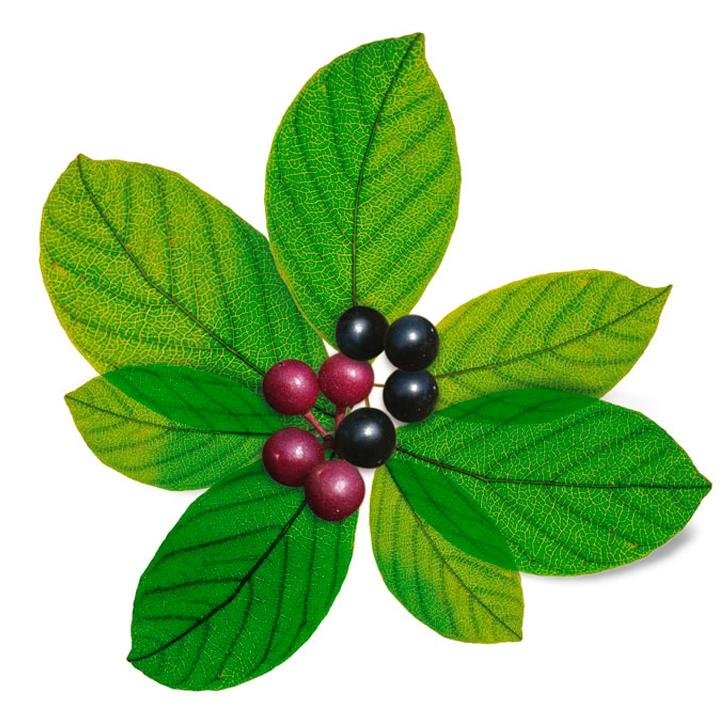Rhamnus purshiana D.C.
Description
It is a tree-bearing ramnaceae native to temperate North America from the Midwest to California, grows in coniferous forests and is cultivated in central Africa.
It has elliptic leaves, whole and slightly toothed, bright green; the flowers are small, with five petals, greenish-white and grouped in umbels; the bark is somewhat aromatic and intensely bitter taste. The fruit is a black drupe containing two or three shiny seeds.
Part used
The bark of the branches and trunk.
Active principles
- Hydroxyanthracene heterosides (6-8%): the major components are the cascarosides (60-70%) A, B, C and D, which are O-heterosides of emodin-anthrone.
- Free anthraquinones: aloemodine, chrysophanol, frangulaemodine and fiscion.
- Others: small amounts of homodianthrones and heterodianthrones.
Pharmacological action
Laxative: the laxative action is due to the hydroxyanthracene heterosides which, once ingested, are not absorbed and reach the colon intact where they are hydrolyzed and transformed by intestinal bacteria into active metabolites. The action is manifested by an increase in intestinal peristalsis by direct stimulation of the nerve endings (by irritation of the mucosa or by action on the neural plexus) and by an increase in the secretion of water and electrolytes into the intestinal lumen which causes an increase in intestinal pressure.
The effect is manifested 6-12 hours after oral administration.
Indications
- Situations that require facilitating defecation: anal fissures, hemorrhoids, after anal or rectal surgery.
- Short-term treatment in cases of acute or occasional constipation.
Contraindications
- Pregnancy and lactation.
- Inflammatory bowel diseases.
- Gastrointestinal obstruction.
- Abdominal pain of unknown origin.
- Dehydration states.
Precautions
Do not use for a period longer than one week without medical supervision.
Drug interactions
- Digitalis: hypokalemia, produced by prolonged consumption of the plant, can enhance the effect of these drugs.
- Quinidine: may favor the appearance of arrhythmias.
- Medications or plants that produce hypokalemia: thiazide diuretics, corticoids, licorice.
- Estrogens: cascara sagrada decreases the intestinal absorption of these compounds, so it can reduce their plasma levels and effects.
- Indomethacin: may decrease its effect by stimulating the synthesis of prostaglandin E2.
Side effects
- It can produce colicky pains and semi-liquid stools or diarrhea.
- It can produce changes in urine coloration, yellow-brownish or reddish depending on the pH, which have no clinical significance.
- Prolonged use may cause dependence due to altered intestinal motility and decreased laxative effect, so that constipation worsens and the dose must be increased.
- Prolonged use may ulcerate the colon mucosa and produce a dark pigmentation of the colon (pseudomelanosis coli) that reverts several months after stopping the consumption of the plant.
- Prolonged use may produce hypokalemia (decreased potassium levels) characterized by weakness and fatigue, albuminuria, and hematuria.
Referencias bibliográficas
Monografía de la SEFIT (Sociedad Española de Fitoterapia).
Manual de Fitoterapia. Encarna Castillo García e Isabel Martínez Solís. 2ª edición Elsevier.
European Medicines Agency (EMA). Committee on Herbal Medicinal Products (HMPC). European Union herbal monograph on Rhamnus purshiana DC cortex. Revision 1. Amsterdam: EMA. Doc. Ref.: EMA/HMPC/726270/2016. Published: 27/7/2020.
C. Cirillo, R. Capasso. Constipation and Botanical Medicines: an overview. Phytotherapy Research. https://doi.org/10.1002/ptr.5410.
